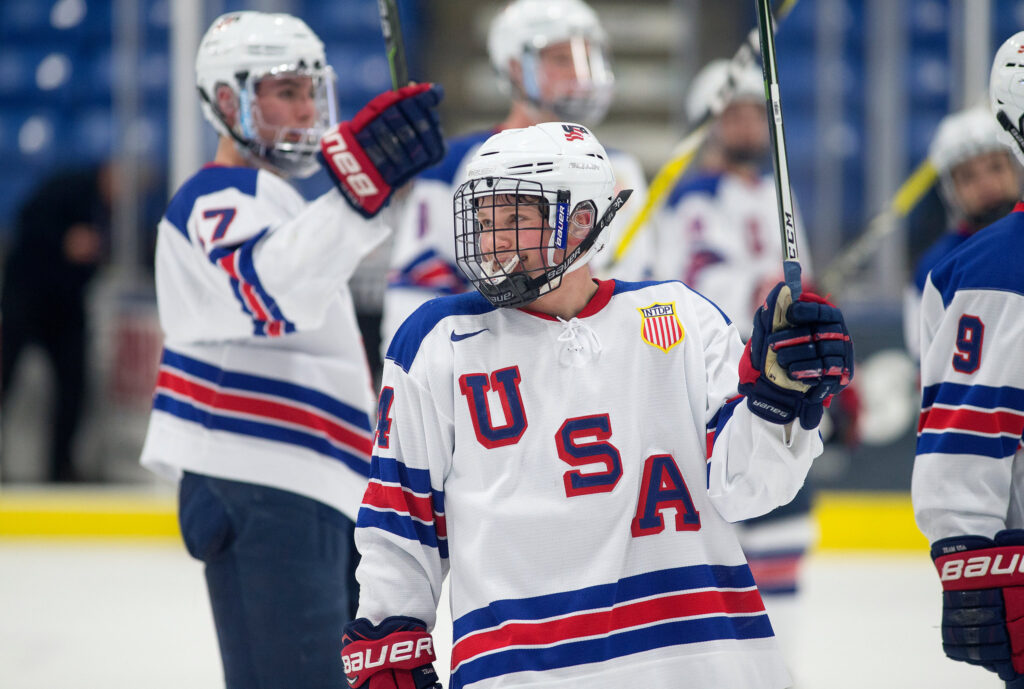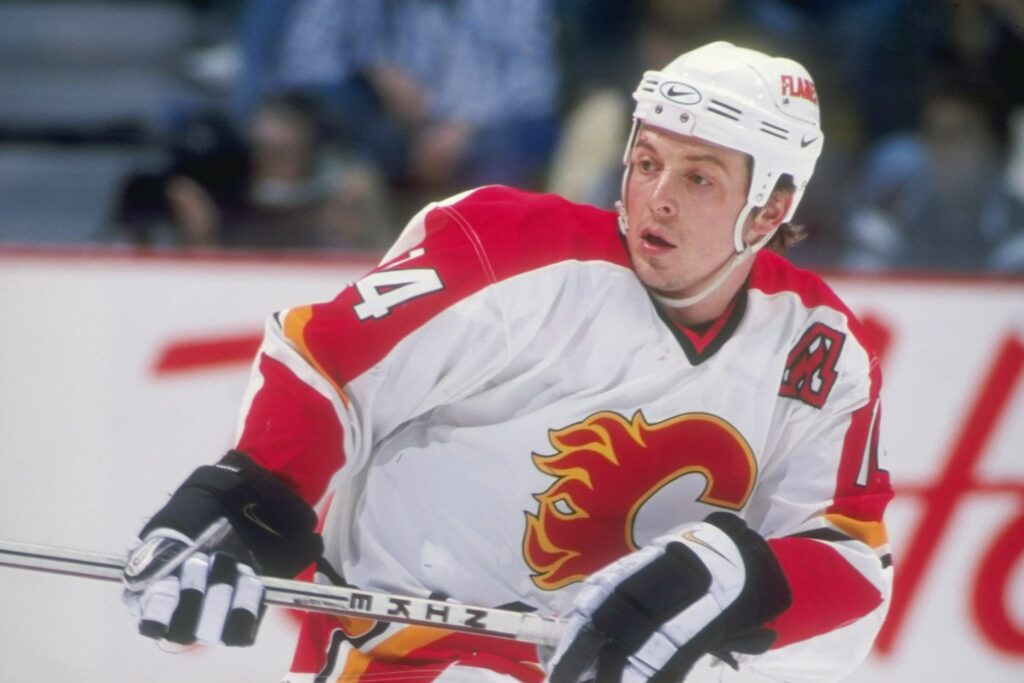In a league where the average player towers over six feet, the presence of an NHL athlete standing well below this mark is an extraordinary feat. Believe it or not, 5’7″ has emerged not just as a height on the roster, but as a statement of talent in the National Hockey League.
Among the shortest NHL players, these athletes defy the gravitational pull of expectations, as evidenced by Matthew Phillips and Cole Caufield, who at their 5’7″ stature challenge the scale of success in professional hockey.
This tenacity is part of a longstanding tradition within NHL history, tracing back to greats like Roy “Shrimp” Worters, the Hockey Hall of Famer and the smallest player in NHL.
Height in NHL may seem like a gatekeeper of the goalie net, but it has not stopped the upwards trajectory of the smallest hockey players who, despite being the shortest athletes in hockey, leverage unparalleled agility and skill to compete—the giants in spirit, if not in stature.
Key Takeaways

Source: nytimes.com
- Short stature is not an inhibition for players in the NHL; they are standing tall in their achievements.
- Players such as Matthew Phillips and Cole Caufield exemplify the skill and persistence of the shortest NHL players.
- Roy “Shrimp” Worters remains a historical figure who set a precedent for height not dictating excellence in hockey.
- NHL player statistics continue to evolve, showing that size diversity contributes to the dynamic landscape of the sport.
- The smallest hockey players demonstrate that success in the NHL comes from the sum of skill and determination, not inches.
Understanding Height’s Role in NHL Success
While sheer physical presence has traditionally been associated with a competitive edge in the National Hockey League, the reality of player performances tells a more nuanced story.
The confluence of agility, skill, and strategy serves to balance the scales of competition, making room for hockey shortest players to distinguish themselves alongside their taller counterparts. This section delves into these dynamics, contrasting the experiences of players at varying heights to shed light on the true impact of stature in the NHL.
Perceptions of Size in the League
The NHL’s fast-paced and physically demanding nature has long fostered the perception that larger athletes have an advantage, particularly in roles such as the goaltender. Yet, hockey size rankings tell only one part of a player’s potential for success.
As demonstrated by numerous athletes who have excelled despite their shorter stature, skills like stickhandling, speed, and hockey IQ are equally—if not more—critical components of elite performance.
Contrasting Smallest and Tallest NHL Players
The history of the NHL height records showcases an extensive range of player sizes, from diminutive dynamos to towering titans. Matthew Phillips and Zdeno Chára exemplify this diversity at its most extreme.
While Phillips, at 5’7″, might be among the hockey shortest players in the league, his determination and talent echo that of Chára, who, at 6’9″, stands as the tallest to have ever played in the NHL. Their coexistence in the league underlines the fact that success on the ice is not exclusively reserved for the physically imposing.
The Evolution of the Smallest Hockey Players
In the annals of NHL history, the presence of the smallest hockey players has consistently challenged the conventional wisdom about the physical requisites for the sport. Herein lies a tale of remarkable athletes who, despite their diminutive size, scaled the heights of professional hockey with determination and finescale skill.
From legendary figures like Roy “Shrimp” Worters to contemporary marvels such as Cole Caufield and Matthew Phillips, the narrative thread weaves through the decades, tracing the impact of the shortest NHL players.
Breaking Stereotypes: Historical Success Stories
These athletes’ triumphs were not just personal milestones; they served as beacon lights that shattered the longstanding stereotypes of size in hockey. Roy Worters, standing only 5’3″, set the bar for goalies with his agility and incredible prowess, leaving behind a legacy for others to follow.
This steadfast drive and resilience carved out a space for short stature players to excel and earn their rightful place among the giants of the game.
From Roy Worters to Today: A Legacy of Short Stature Players
Generations later, the indomitable spirit of short stature players lives on. These athletes have utilized their agility, skillset, and matchless determination to rewrite records and redefine what it means to be a professional hockey player.
The legacy that began with Worters now thrives in players like Caufield and Phillips, who persist in breaking the mold and inspiring future talents to pursue their NHL dreams irrespective of their height.
| Player | Height | Position | Notable Achievement |
|---|---|---|---|
| Roy “Shrimp” Worters | 5’3″ | Goalie | Hart Trophy Winner |
| Cole Caufield | 5’7″ | Forward | Exceptional Goal Scorer |
| Matthew Phillips | 5’7″ | Forward | Showcasing High Skill Level |
The ongoing success stories of the smallest hockey players are a testament to their unyielding spirit and the evolving landscape of the NHL, where skill, heart, and perseverance are as valuable as any physical attribute. These players are not merely participants in the league; they are vital contributors who continue to expand the fabric of NHL history.
Shortest NHL Players: In 2024 & Through Hockey History

Source: uwbadgers.com
The landscape of the NHL is marked by players of varied statures, where the shortest NHL players have made their indelible marks. The 2024 season has seen remarkable talent from these athletes, highlighting the fact that size does not eclipse skill on the ice.
Forward Cole Caufield and winger Bobby Trivigno, both standing at an identical height of 5’7″, embody the notion that shortest athletes in hockey can exhibit adaptability, resilience, and superior technical ability.
These players, joining the ranks of historical figures like Roy “Shrimp” Worters, not only enrich NHL player statistics but also expand the narrative on the capability and success of shorter players within the sport. The following data aptly presents a snapshot of the dynamic presence and contributions of the shortest NHL players, past and present.
| Player Name | Height | Weight | Position | Teams Played For |
|---|---|---|---|---|
| Roy Worters | 5’3″ | 135 lbs | Goalie | New York Americans, Pittsburgh Pirates |
| Cole Caufield | 5’7″ | 174 lbs | Forward | Montreal Canadiens |
| Bobby Trivigno | 5’7″ | 161 lbs | Winger | Undetermined |
It is evident from the table that the shortest athletes in hockey are not hindered by their stature. Rather, they utilize their unique skill sets to compete with tenacity among taller peers. The continuity of such players in the NHL demonstrates the league’s acknowledgment and appreciation for a diverse profile of athletes.
“In the NHL, it’s not the size of the player but the size of the player’s heart that counts.” – A testament to the shortest NHL players who bring passion and vigor to the rink.
As the 2024 NHL season progresses, these players continue to push the boundaries and inspire both fans and aspiring hockey athletes alike, contributing significantly to the sport’s rich tapestry of players from all walks of life.
Their performances, against the odds, forge a powerful story of inclusivity and achievement in the competitive realm of professional hockey.
2024 Ranking of Smallest NHL Talents
The landscape of the National Hockey League, although often associated with physicality and size, continues to be shaped by players who defy traditional size metrics. In the year 2024, a new cadre of diminutive but highly skilled players have earned their spots among the elite, not just through their presence, but by their measurable impact on the game.
The following discussion delves into the player statistics that place these athletes at the forefront of NHL height records and exemplifies their significance within the realm of professional hockey.
Key Statistics: Weight and Performance Metrics
At a modest 140 pounds, Matthew Phillips claims the title of the lightest player, his agility and speed compensating for what he lacks in mass.
Players like Trey Fix-Wolansky and Domenick Fensore, although standing at 5’7″, bring performance metrics that rival their heavier and taller peers, emphasizing that height in NHL is but one aspect of a player’s profile.
These statistics not only challenge the preconceptions about size in hockey but also highlight the evolution of the game into one that values versatility and skill.
Insights from Coaches and Teammates
The heart and tenacity found in smaller stature players can sometimes overshadow the advantage of their opponents’ reach and weight.
This sentiment echoes among coaches who frequently cite examples like Logan Stankoven’s exceptional play during WHL playoffs, showcasing that determination often outshines physical limitation.
Kailer Yamamoto is regularly recognized by his teammates for his relentless playstyle, reinforcing the idea that heart and passion play a significant role in the makeup of a successful NHL player.
As the NHL continues to advance, the stories of these players serve as a testament to the richness and diversity that small stature players add to the league, challenging the status quo, and redefining NHL player statistics.
Their steady strides and outstanding contributions make the height records in hockey an area of awe, respect, and continuous excitement for fans and aspiring athletes alike.
Techniques and Strategy: How Short NHL Players Compete
In the world of professional hockey, the shortest athletes in hockey have made a significant mark by perfecting techniques and strategies that turn their size into an advantage. Key to their competitiveness on the ice is their exceptional speed and agility, allowing them to weave through defenses and create scoring opportunities where larger players may not.
The Importance of Speed and Agility for Smaller Players
Shorter players like Mats Zuccarello have utilized their agility to maintain puck control and navigate tight spots, evading checks from larger opponents. Speed is a defining attribute, offering hockey’s shortest players an edge in races for loose pucks, quick breaks, and backchecking.
By keeping the gameplay fast-paced, they’re able to dictate the flow and keep larger players reactive rather than proactive.
Technique Over Size: Skill Development and Playmaking
Without the intrinsic advantage of size, hockey size rankings show that the shortest athletes in hockey focus heavily on skill development, particularly in areas of shooting, stickhandling, and playmaking.
Alex DeBrincat, recognized for his sharp shooting accuracy, demonstrates how refined skills can lead to success against the odds. Their dedication to continual improvement enables them to perform alongside the talles
Comparing Shortest NHL Athletes Across Positions
In the NHL, size is often overshadowed by skill and perseverance, as evidenced by the notable achievements of the shortest NHL players. From swift forwards to nimble defensemen, these athletes have adapted their game to compete at an elite level despite not fitting the traditional mold of the taller hockey player.
Forwards: Overcoming the Height Barrier
Among the ranks of forwards, names like Cole Caufield and Cam Atkinson emerge as paragons of prowess. These players, who are not only some of the shortest athletes in the league but also among the most skilled, utilize speed, agility, and exceptional on-ice vision to find their place in the scoring charts.
Their success is an affirmation that in the realm of offense, hockey IQ and hand-eye coordination trump the advantages that height might confer.
Defensemen and Goalies: Unique Challenges for Shorter Players
The defensive zone presents a different set of challenges for shorter players, where reach and physical presence are traditionally prized. Yet, players like Jared Spurgeon defy these expectations with robust defensive play that does not compromise on mobility or tactical acumen.
Their tenacity and expert positioning on the ice underscore the evolving nature of NHL player statistics, where heart and hustle provide the necessary edge for those not blessed with towering height.
As the league continues to track NHL height records, these athletes are not simply footnotes but are central to the ongoing narrative of the sport, offering inspiration and exhibiting how the shortest can stand tall among giants.
Milestone Achievements by Hockey’s Shortest Athletes

Source: bleacherreport.com
The NHL has long been a stage for athletes of all sizes to showcase their talent and tenacity. In the chronicles of NHL history, the shortest NHL players have persistently defied odds, making monumental strides that have cemented their places among the sport’s most celebrated.
Their contributions to the league spotlight the significance of skill and determination over the physical advantage of height in NHL.
Hall of Fame Inductees with Impressive Height Stats
Among the pantheon of hockey legends, short-statured players have earned their rightful place. Roy “Shrimp” Worters stands tall in the Hockey Hall of Fame, an honor that illuminates the attainability of hockey’s highest accolades regardless of a player’s height.
His legacy paves the way for future athletes, proving that the heart of a champion knows no physical boundaries.
Record-Breaking Performances and Career Highs
Martin St. Louis, another diminutive powerhouse, exemplifies how the shortest NHL players can capture the essence of the sport and perform at elite levels. His illustrious career is a collection of career highs and record-shattering moments that have elevated the profile of height in NHL debates.
St. Louis and his fellow short-statured companions continue to redraw the boundaries of success in NHL player statistics, inspiring a new generation to reach for greatness on the ice.
Inspiration and Impact Beyond the Ice
The narrative surrounding the shortest athletes in hockey is being rewritten as these players are increasingly recognized for their unique contributions to the sport.
While initially their size may have been seen as a detriment, their determined spirit and undeniable skill are making a lasting impression not just on NHL player statistics, but on the cultural fabric of the sport itself.
The Role Model Effect: Short Players as Icons to Aspiring Athletes
Source: medium.com
Against the backdrop of conventional expectations in the NHL, the success of shorter players has had a profound effect on young, aspiring athletes who might otherwise be discouraged by their stature.
Icons such as Martin St. Louis —known for his tenacity and leadership —have paved the way for the stars of today. Stories of underdogs thriving in the competitive space of professional hockey serve as a beacon of hope to those dreaming of following in their footsteps.
Changing the Narrative: Media and Cultural Impact of Smaller Players
As short stature players continue to excel, the media has played a pivotal role in altering the public’s perception of an ideal hockey player. Highlighting the achievements of players like Theo Fleury and Yanni Gourde, the narrative is decidedly shifting towards celebrating diversity in player profiles.
These athletes’ journeys tell a compelling story of resilience, contributing richly to the NHL’s tapestry and inspiring a narrative change that challenges the status quo.
- Success beyond size: Highlighting the importance of skill and determination through the lens of hockey’s shortest players.
- Role models: How Theo Fleury and others inspire the next generation of athletes to overcome adversity and reach for NHL stardom.
- Media impact: The evolving portrayal and increased recognition of shorter athletes contributing to a new era in hockey culture.
Conclusion
The narrative surrounding the stature of NHL players often gravitates towards the physical dominance of its towering athletes. However, the narratives within NHL history are rich with evidence that the shortest NHL players have continuously shattered this conventional image, showcasing that height is far from being the ultimate measure of one’s prowess on the ice.
Through sheer commitment, an embrace of their unique attributes, and an unwavering focus on honing their skills, these smallest hockey players have etched their names among the greats of the game.
The successes of figures like Roy Worters, and the contemporary achievements of athletes such as Cole Caufield and Matthew Phillips, serve to reinforce that the tape measure does not capture the spirit, tenacity, or skill of an hockey player.
This collective experience reinforces an encouraging message to the hockey community: greatness beckons for those willing to put in the work, irrespective of physical stature. It is not just the size of the player in the fight, but the size of the fight in the player that defines their legacy in NHL history.
As the NHL moves forward, it carries with it the legacy of these resilient individuals who have demonstrated that the ice rink is a ground for inclusivity and diversity in talent. Their stories are foundational to the progressive narrative of the sport, one where smallest hockey players find their place and prosper.
These sportsmen continue to serve as a beacon of inspiration, encouraging a future generation to lace up their skates and dream big, no matter their size.
FAQ
Who are some of the shortest NHL players in 2024?
Matthew Phillips and Cole Caufield are among the shortest NHL players in 2024, both standing at 5’7″.
Can shorter players find success in the NHL?
Absolutely. NHL history has shown that players with shorter stature, such as Roy “Shrimp” Worters and Martin St. Louis, have achieved significant success, including winning major awards and accolades.
What was the height of the shortest player in NHL history?
The shortest player in NHL history was Roy “Shrimp” Worters, who stood at 5’3″. Despite his height, Worters had a successful 13-season career and is remembered as one of the smallest hockey players to play at such a high level.
How do shorter players inspire future generations of hockey athletes?
Shorter players act as role models, showing that success is not limited by size. Their determination and achievements inspire aspiring athletes to pursue their NHL dreams, regardless of stature.


